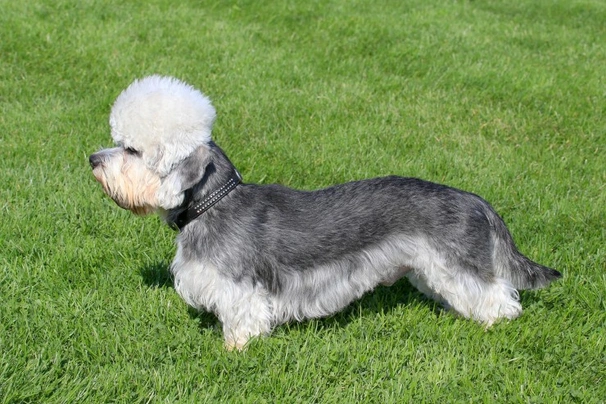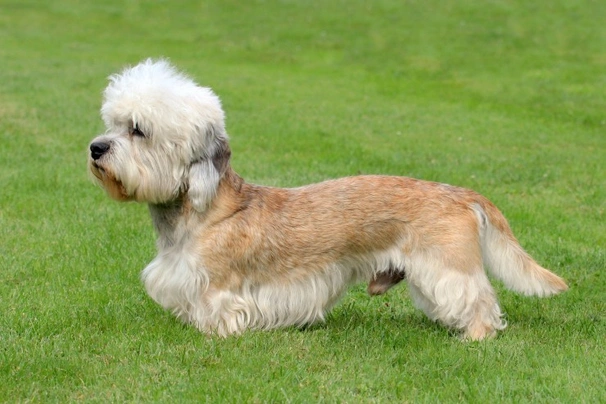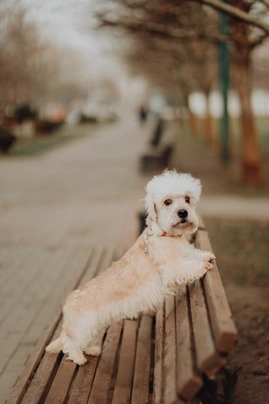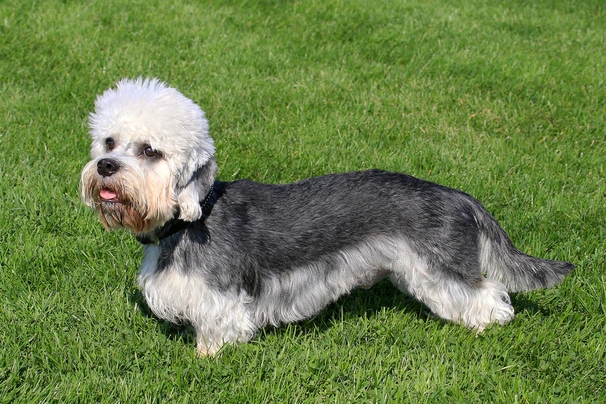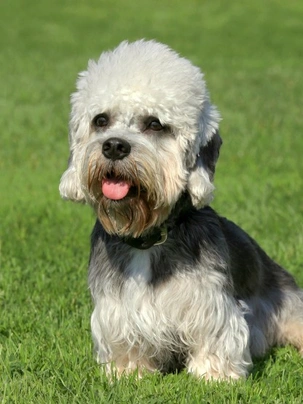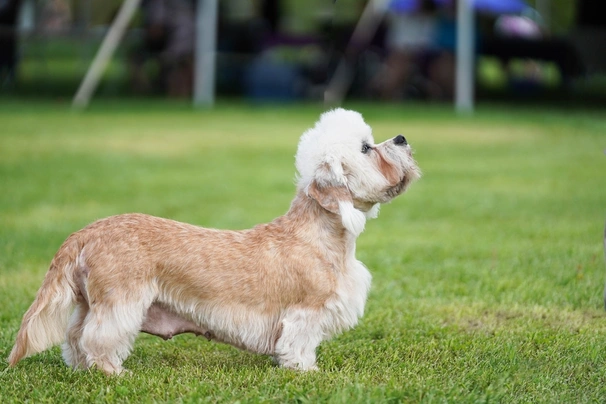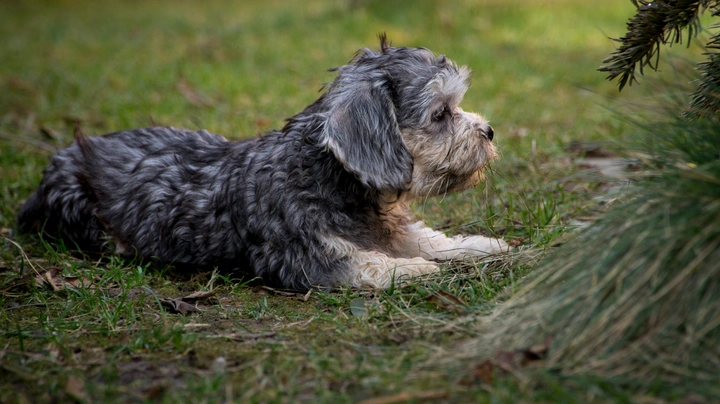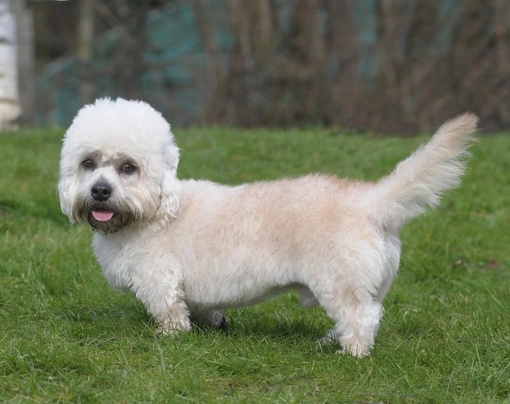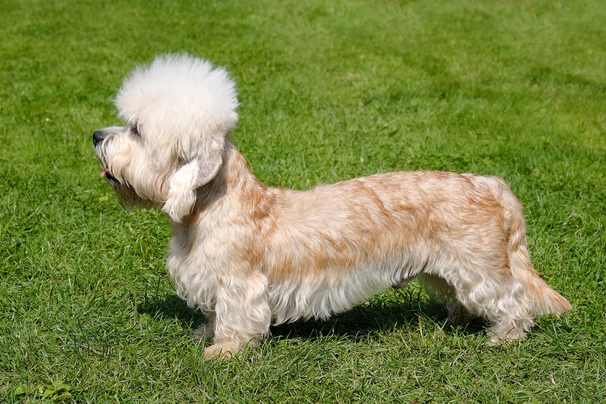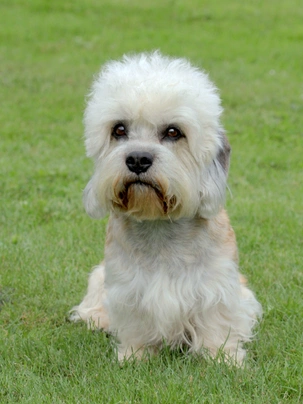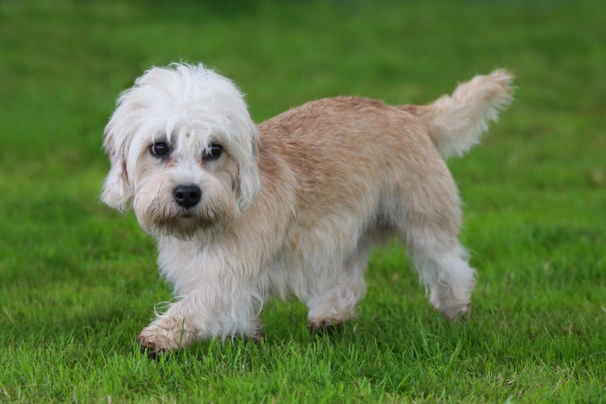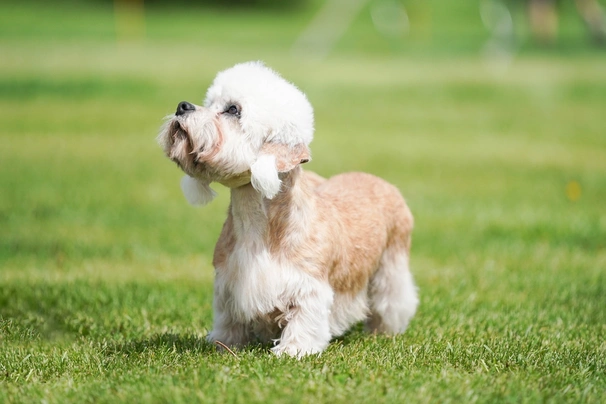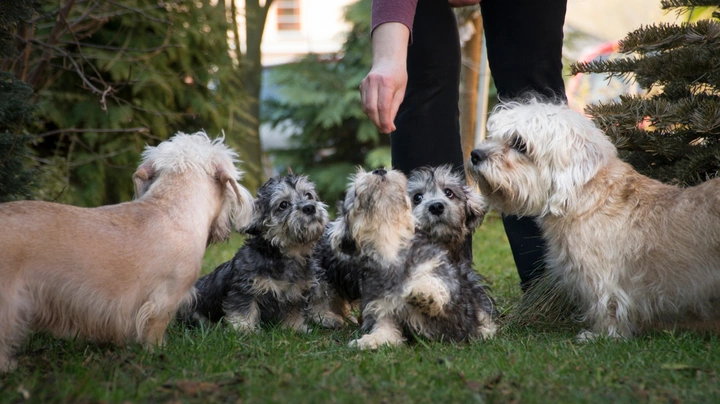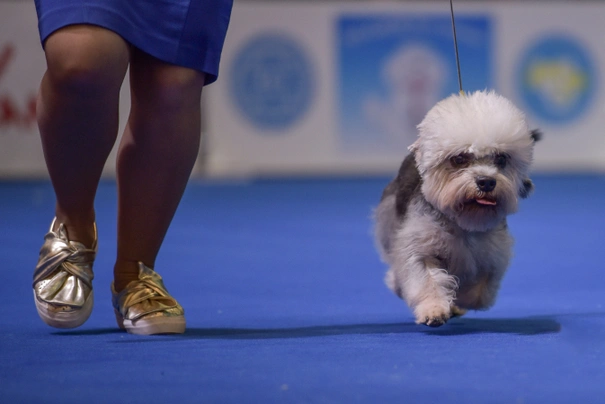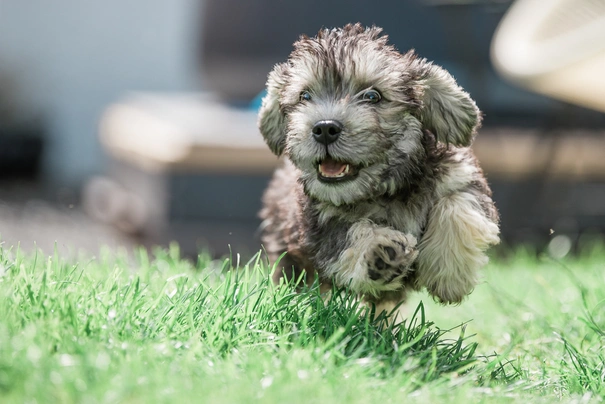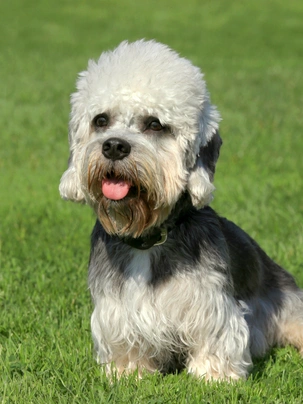Dandie Dinmont Terrier
Pros
Cons
Introduction of the Dandie Dinmont Terrier
The Dandie Dinmont is a native breed that hails from the Scottish Borders where they were once used as highly prized hunting dogs. They are short-legged and boast long bodies with an abundant amount of hair on their heads which adds to their endearing unique looks and appeal. Dandies are a rare breed even though they such adorable dogs that are known to be devoted to children.
They are intelligent although they do boast being a little wilful when it pleases them but with this said the Dandie Dinmont makes for a wonderful companion and family pet. The breed is on The Kennel Club’s vulnerable native breed list and sadly the future of the Dandie Dinmont is now a big concern with few puppies being bred and registered every year. As such anyone wanting to share a home a with a Dandie Dinmont Terrier would need to register their interest with breeders for the pleasure of doing so.
History of the Dandie Dinmont Terrier
The Dandie Dinmont Terrier was once known as a “Mustard & Pepper Terrier” and they are a native breed having been bred and developed on the Scottish Borders where the breed was highly prized hunting and working dogs. The breed is an ancient one dating back to the 1700’s although it was Sir Walter Scott who brought the Dandie to the attention of the country when he wrote a novel about Dandie Dinmont a character in the book who owned Mustard & Pepper Terriers. As such the breed was later to be given the name the Dandie goes by today.
Dandies were bred to hunt and therefore needed to be courageous and bold more especially when they had to deal with badgers and otters. The first Dandie Dinmont Terrier Club was established in 1875 and a breed standard was soon drawn up afterwards. The breed’s popularity grew over the following years but sadly interest in Dandie Dinmonts waned in more recent times. Today there are three UK clubs 2 of which are in England and one in Scotland but the Dandie Dinmont Terrier has been placed on the Kennel Club’s vulnerable native breed list with few puppies being bred and registered every year which is great cause for concern.
Interesting facts about the breed
- Is the Dandie Dinmont a vulnerable breed? Yes they have been placed on the Kennel Club’s list of vulnerable native breeds and anyone wanting to share a home with a Dandie would need to register their interest with breeders and go on a waiting list for the pleasure of doing so
- The Dandie Dinmont Terrier Breed Club is the 3rd oldest in the world
- There is some belief that the Dandie Dinmont is oldest and the purest of all terrier breeds
- They were given their name after a character in a novel by Sir Walter Scott which he wrote in 1815
- The breed was originally known as the Mustard and Pepper Terrier
- Dandies have always been highly prized working terriers on the Scottish Borders
- The breed was a firm favourite with poachers and gypsies
- All the Dandies we see today are descendants of a poacher’s dog
Appearance of the Dandie Dinmont Terrier
Height at the withers: Males 20 - 28 cm Females 20 - 28 cm
Average weight: Males 8.2 - 10.9 kg Females 8.2 - 10.9 kg
The Dandie Dinmont is a very unique looking short-legged dog that boasts a long body and large head that's accentuated by the way they are clipped. Their heads are big but always in proportion to the rest of a dog's body. Their skulls are broad but narrower at their eyes. Their foreheads are very domed and their heads are well covered in extremely soft silky hair. Cheeks taper gradually down to a rather deep and powerful muzzle that boasts a triangular bare area that points back to a dog's eyes and their noses are black which adds to the Dandie's overall charming looks.
Their eyes are set wide apart and are a rich dark hazel in colour. They are large and set low with dogs always showing a bright and alert expression in them. Ears are quite droopy and set well back on a dog's head. They are wide apart and sit low on a dog's skull but close to their cheeks. They are broader at the top but taper to the tips. The skin and cartilage on their ears is very thin and they are covered in soft straight darker hair that matches the rest of a dog's coat colour.
The Dandie Dinmont has a strong jaw with a perfect scissor bite where their upper teeth neatly overlap their lower ones. Their teeth are very strong more especially their canines which are quite big for such a small dog. The inside of a Dandie's mouth is either black or dark coloured. Necks are very well muscled and strong showing a great deal of power and set nicely into a dog's shoulders which are well laid back. Their front legs are short but they are extremely powerful being well developed and showing a good amount of bone.
A Dandie's body is long yet strong and very flexible with their ribs being well sprung and nicely rounded. Chests are well developed being well let down at the front between a dog's legs. They are low at the shoulders with their back having a slight curve to the loins before gradually dropping down to the root of the tail. Their backbones are well muscled and strong.
Hindquarters are strong with a dog's back legs being longer than their front ones. Thighs are well developed and powerful. Feet are nicely rounded and well-padded with their back feet being smaller than their front ones. Tails are short and thick at the base before tapering to the tip. Dogs carry their them in the shape that's reminiscent of a scimitar.
When it comes to their coat the Dandie Dinmont boasts having a double coat that consists of a soft and very linty undercoat and a much harder topcoat. The hair is not wiry but rather crispy to the touch. It's the way the hair lies that makes the Dandie stand out from other breeds because it lies in "pencils". Their front legs have feathering and the upper parts of their tails are well covered in wiry hair while the underside has softer feathering. Accept breed colours for Kennel Club registration are as follows:
- Pepper - ranges from a dark bluish/black to a light silvery grey with a profuse silvery/white topknot
- Mustard - ranges from a reddish brown to a pale fawn colour with a profuse creamy/white topknot
Dogs with either colour have slightly lighter feathering on their front legs while the underside of their tails are lighter than the topsides of them which are darker than the rest of the body.
It is worth noting that the accepted breed colours for Kennel Club registration can differ from those set out in the breed standard which are as follows:
- Pepper – a dog’s coat can be a dark bluish black right through to a light silvery grey colour with intermediate shades being highly desirable with dogs having a profuse topknot that’s silvery white
- Mustard – a dog’s coat can a reddish brown right through to pale fawn in colour with dogs having a profuse topknot that’s creamy white and their legs as well as their feet being a darker shade than that on a dog’s head
Dandies have feathers on their front legs that are lighter in colour than the hair on the fore part of their legs and are allowed to have a little white on their chests under the UK Kennel Club breed standard. They are also allowed to have white nails although white on a dog’s feet is highly undesirable. The hair under their tails is a lighter colour than on the upperside of it which is darker than the colour found on a dog’s body.
Gait/movement
When a Dandie Dinmont Terrier moves they do so with a strong free moving and easy stride showing great forward reach and lots of propulsion from behind.
Faults
The Kennel Club frowns on any exaggerations or departures from the breed standard and would judge the faults on how much they affect a dog's overall health and wellbeing as well as their ability to perform.
Males should have both testicles fully descended into their scrotums and it is worth noting that a dog can be a little lighter or heavier as well as slightly taller or shorter than set out in the Kennel Club breed standard which is only given as a guideline.
Temperament of the Dandie Dinmont Terrier
The Dandie Dinmont Terrier is a small dog with a big personality being a typical terrier at heart. They do not know their size and would happily take on a bigger dog if they feel they have to. With that said they are known to be very affectionate friendly and placid dogs by nature. They are not the best choice for first time owners because these little terriers can prove rather challenging to train thanks to their stubborn streak. However in the right hands and with the right amount of socialisation and training the Dandie does make for a great family pet.
Like most terriers the Dandie likes to be kept busy and does not do well if they are left on their own for longer periods of time much preferring the company of people. As such they are good choice for people where one person usually stays at home when everyone else is out of the house. It these little terriers are not given enough exercise and mental stimulation on a daily basis they quickly learn to amuse themselves which typically involves them developing some unwanted and often destructive behaviours. This includes separation anxiety and being destructive around the house and excessive barking. Dandies are known to like the sound of their own voices which is something that needs to be gently nipped in the bud when dogs are still young or it could become a real issue.
Are they a good choice for first time owners?
Dandie Dinmonts are the perfect choice for first time dog owners because they are so amenable and people-oriented loving nothing more than to please and to entertain their families. They are particularly good with young children and older people too although playtime can get a bit boisterous at times.
What about prey drive?
Having been bred to hunt Dandies have a high prey drive and will happily chase anything that moves or that tries to run away from them. As such care should always be taken as to where and when a dog can run off the lead more especially if there is wildlife and/or livestock close by bearing in mind that a Dandie would likely turn a deaf ear to a command and go off chasing after anything they have spotted in the distance.
What about playfulness?
Dandies have a very playful side to their natures and love to entertain and be entertained. They are known to be a little mischievous when the mood takes them and being so clever they quickly understand how to please and owner or get their own way when they want something.
What about adaptability?
Although Dandies are highly adaptable small dogs they are better suited to people who have large well-fenced secure back gardens that a dog can safely roam in whenever possible to really let of steam as often as possible.
What about separation anxiety?
Dandies form strong ties with their families but they are not generally known to suffer from separation anxiety providing they are not left to their own devices for too long. Any breed that is left for long periods of time could develop unwanted and destructive behavioural issues which is their way of relieving stress and boredom.
What about excessive barking?
Dandies are not known to be “barkers” like many other terrier breeds and will typically only voice an opinion when they think it is really necessary which is why they make such good watchdogs.
Do Dandie Dinmont Terriers like water?
Most Dandies like swimming and will take to the water whenever they can more especially when the weather is hot. However if anyone who owns a dog that does not like water should never force them to go in because it would just end up scaring them. With this said care should always be taken when walking a dog off the lead anywhere near more dangerous watercourses just in case a dog decides to leap in and then needs rescuing because they cannot get out of the water on their own.
Are Dandie Dinmont Terriers good watchdogs?
Dandies are natural watchdogs because they are always on the alert to what goes on in their environment. They have a lovely deep bark for such small dogs which many people find surprising. However rarely would a Dandie show any sort of aggressive behaviour when someone they don’t know is around preferring to keep their distance stand their ground and bark.
Intelligence / Trainability of the Dandie Dinmont Terrier
Dandie Dinmonts are smart little terriers but their stubborn streak can make training them a bit challenging. With this in mind their socialisation and training has to start as soon as possible and it has to be consistent from the word go. They do not respond well to any sort of harsh correction or training methods but they do answer well to positive reinforcement. The key to successfully train a Dandie is to be firm always fair and very patient with them.
Like all puppies Dandies are incredibly cute when young and it is all too easy to spoil them when they first arrive in new homes. As soon as a puppy is nicely settled owners must start out as they mean to go on by laying down ground rules and boundaries so that a puppy understands what is expected of them. It helps establish a pecking order and who the alpha dog is in the household. The first commands a puppy should be taught are as follows:
- Come
- Sit
- Stay
- Heel
- Quiet
- Leave it
- Down
- Bed
Children and other
The Dandie does make a great family pet but for families where the children are older and therefore know how to behave around dogs. Care should be taken when there are toddlers around and any interaction between them and a dog has to be supervised by an adult to make sure things stay friendly and playtime does not get too boisterous.
Care has to be taken when Dandies are around other animals and smaller pets which includes cats because being terriers they might just see them as "fair game". With this said if they have grown up with a cat in the house they generally accept them being around but would think nothing of chasing a neighbour's cat if they ever ventured into a back garden. These little terriers are known to be good around other dogs especially if they have been well socialised from a young age.
Health of the Dandie Dinmont Terrier
The average life expectancy of a Dandie Dinmont is between 11 and 13 years when properly cared for and fed an appropriate good quality diet to suit their ages.
Like so many other breeds the Dandie is known to suffer from a few hereditary health issues which are worth knowing about if you are planning share your home with one of these active and good-looking dogs. The conditions that seem to affect the breed the most include the following:
- Hip dysplasia – dogs should be hip scored by a BVA registered vet
- Elbow dysplasia – dogs should be elbow tested by a BVA registered vet
- Goniodysgenesis/Primary glaucoma (G) – dogs should be tested annually under the BVA/KC eye scheme
- Intervertebral disc disease
- Portosystemic shunt
- Cushing’s disease
- Urolithiasis/bladder stones
It is worth noting that the Kennel Club’s average COI for the breed currently stands at 9.4%.
What about vaccinations?
Dandie Dinmont puppies would have been given their initial vaccinations before being sold but it is up to their new owners to make sure they have their follow-up shots in a timely manner with the vaccination schedule for puppies being as follows:
- 10 -12 weeks old bearing in mind that a puppy would not have full protection straight away but would be fully protected 2 weeks after they have had their second vaccination
There has been a lot of discussion about the need for dogs to have boosters. As such it's best to talk to a vet before making a final decision on whether a dog should continue to have annual vaccinations which are known as boosters.
What about spaying and neutering?
A lot of vets these days recommend waiting until dogs are slightly older before spaying and neutering them which means they are more mature before undergoing the procedures. As such they advise neutering males and spaying females when they are between the ages of 6 to 9 months old and sometimes even when a dog is 12 months old.
Other vets recommend spaying and neutering dogs when they are 6 months old but never any earlier unless for medical reasons. With this said many breeds are different and it is always advisable to discuss things with a vet and then follow their advice on when a dog should be spayed or neutered.
What about obesity problems?
As with other breeds some Dandies gain weight after they have been spayed or neutered and it's important to keep an eye on a dog's waistline just in case they do. If a dog starts to put on weight it's important to adjust their daily calorie intake and to up the amount of exercise they are given. Older dogs too are more prone to gaining weight and again it's essential they be fed and exercised accordingly because obesity can shorten a dog's life by several years. The reason being that it puts a lot of extra strain on a dog's internal organs including the heart which could prove fatal.
What about allergies?
Dandies are not known to suffer from allergies but it's important for a dog to see a vet sooner rather than later if one flares up. Allergies can be notoriously hard to clear up and finding the triggers can be challenging. With this said a vet would be able to make a dog with an allergy more comfortable while they try to find out the triggers which could include the following:
- Certain dog foods that contain high levels of grains and other cereal-type fillers
- Airborne pollens
- Dust mites
- Environment
- Flea and tick bites
- Chemicals found in everyday household cleaning products
Participating in health schemes
All responsible Dandie Dinmont Terrier breeders would ensure that their stud dogs are tested for known hereditary and congenital health issues known to affect the breed by using the following schemes:
- Hip scoring by a registered BVA vet or through the Animal Health Trust (AHT)
- Elbow tested by a registered BVA vet or through the Animal Health Trust (AHT)
- Eye tested annually under the BVA/KC eye scheme
What about breed specific breeding restrictions?
Apart from the standard breeding restrictions that are in place for all Kennel Club registered breeds there are no other breed specific breeding restrictions in place for the Dandie Dinmont.
What about Assured Breeder Requirements?
The Kennel Club strongly recommends that all breeders use the following test on their dogs:
Caring for the Dandie Dinmont Terrier
As with any other breed Dandies need to be groomed on a regular basis to make sure their coats and skin are kept in top condition. They also need to be given regular daily exercise to ensure they remain fit and healthy. On top of this dogs need to be fed good quality food that meets all their nutritional needs throughout their lives.
Caring for a Dandie Dinmont Terrier puppy
Dandie puppies are boisterous and full of life which means it's essential for homes and gardens to be puppy-proofed well in advance of their arrival. A responsible breeder would have well socialised their puppies which always leads to more outgoing confident and friendly dogs right from the word go. With this said any puppy is going to feel vulnerable when they leave their mother and littermates which must be taken into account. The longer a puppy can remain with their mother the better although it should never be for too long either.
It's best to pick a puppy up when people are going to be around for the first week or so which is the time needed for a puppy to settle in. Puppy-proofing the home and garden means putting away any tools and other implements that a boisterous puppy might injure themselves on. Electric wires and cables must be put out of their reach because puppies love chewing on things. Toxic plants should be removed from flowerbeds and the home too.
Puppies need to sleep a lot to grow and develop as they should which means setting up a quiet area that's not too out of the way means they can retreat to it when they want to nap and it's important not to disturb them when they are sleeping. It's also a good idea to keep "playtime" nice and calm inside the house and to have a more active "playtime" outside in the garden which means puppies quickly learn to be less boisterous when they are inside.
The documentation a breeder provides for a puppy must have all the details of their worming date and the product used as well as the information relating to their microchip. It is essential for puppies to be wormed again keeping to a schedule which is as follows:
- Puppies should be wormed at 6 months old
- They need to be wormed again when they are 8 months old
- Puppies should be wormed when they are 10 months old
- They need to be wormed when they are 12 months old
Things you'll need for your puppy
There are certain items that new owners need to already have in the home prior to bringing a new puppy home. It's often a good idea to restrict how much space a puppy plays in more especially when you can't keep an eye on what they get up to bearing in mind that puppies are often quite boisterous which means investing in puppy gates or a large enough playpen that allows a puppy the room to express themselves while keeping them safe too. The items needed are therefore as follows:
- Good quality puppy or baby gates to fit on doors
- A good well-made playpen that's large enough for a puppy to play in so they can really express themselves as puppies like to do
- Lots of well-made toys which must include good quality chews suitable for puppies to gnaw on bearing in mind that a puppy will start teething anything from when they are 3 to 8 months old
- Good quality feed and water bowls which ideally should be ceramic rather than plastic or metal
- A grooming glove
- A slicker brush or soft bristle brush
- Dog specific toothpaste and a toothbrush
- Scissors with rounded ends
- Nail clippers
- Puppy shampoo and conditioner which must be specifically formulated for use on dogs
- A well-made dog collar or harness
- A couple of strong dog leads
- A well-made dog bed that's not too small or too big
- A well-made dog crate for use in the car and in the home that's large enough for a puppy to move around in
- Baby blankets to put in your puppy's crate and in their beds for when they want to nap or go to sleep at night
Keeping the noise down
All puppies are sensitive to noise including Dandie Dinmont puppies. It's important to keep the noise levels down when a new puppy arrives in the home. TVs and music should not be played too loud which could end up stressing a small puppy out making them withdrawn timid and shy.
Keeping vet appointments
As previously mentioned Dandie Dinmont puppies would have been given their first vaccinations by the breeders but they must have their follow up shots which is up to their new owners to organise. The vaccination schedule for puppies is as follows:
- 10 -12 weeks old bearing in mind that a puppy would not have full protection straight away but would only be fully protected 2 weeks after they have had their second vaccination
When it comes to boosters it's best to discuss these with a vet because there is a lot of debate about whether a dog really needs them after a certain time. However if a dog ever needed to go into kennels their vaccinations would need to be fully up to date.
What about older Dandie Dinmont Terriers when they reach their senior years?
Older Dandie Dinmonts need lots of special care because as they reach their golden years they are more at risk of developing certain health concerns. Physically a dog's muzzle may start to go grey but there will be other noticeable changes too which includes the following:
- Coats become coarser
- A loss of muscle tone
- They can either become overweight or underweight
- They have reduced strength and stamina
- Older dogs have difficulty regulating their body temperature
- They often develop arthritis
- Immune systems do not work as efficiently as they once did which means dogs are more susceptible to infections
- Older dogs change mentally too which means their response time tends to be slower as such they develop the following:
- They respond less to external stimuli due to impaired vision or hearing
- They tend to be a little pickier about their food
- They have a lower pain threshold
- Become intolerant of any change
- Often an older dog can feel disorientated
Living with a Dandie Dinmont Terrier in their golden years means taking on a few more responsibilities but these are easily managed and should include looking at their diet the amount of exercise they are given how often their dog beds need changing and keeping an eye on the condition of their teeth.
Older dogs need to be fed a good quality diet that meets their needs at this stage of their lives all the while keeping a close eye on a dog's weight. A rough feeding guide for older dogs is as follows bearing in mind they should be fed highly digestible food that does not contain any additives:
- Protein content should be anything from 14 – 21%
- Fat content should be less than 10%
- Fibre content should be less than 4%
- Calcium content should be 0.5 – 0.8%
- Phosphorous content should be 0.4 – 0.7%
- Sodium content should be 0.2 – 0.4%
Older dogs don't need the same amount of daily exercise as a younger dog but they still need the right amount of physical activity to maintain muscle tone and to prevent a dog from putting on too much weight. All dogs need access to fresh clean water and this is especially true of older dogs when they reach their golden years because they are more at risk of developing kidney disorders.
Grooming of the Dandie Dinmont Terrier
Dandies boasts having a short coat but very little to no undercoat and as such they need to be brushed regularly just to keep things tidy and to make sure their skin in kept in good condition. However these little terriers should be clipped and their coats shaped every 8 to 12 weeks. This is a task that's best left up to a professional dog groomer but it does make keeping a Dandie's coat looking good that much easier in between visits to a grooming parlour.
It's also important to check a dog's ears on a regular basis and to clean them when necessary. If too much wax is allowed to build up in a dog's ears it can lead to a painful infection which can be hard to clear up. In short prevention is often easier than cure when it comes to ear infections.
Exercise of the Dandie Dinmont Terrier
Dandies are active energetic terriers which means they like to be kept busy. As such they need to be given a minimum of an hour's exercise on a daily basis for them to be truly happy well-rounded dogs. Because they are such clever little dogs they also need lots of mental stimulation on daily basis to prevent boredom from setting in which can lead to dogs developing unwanted behavioural issues.
With this said young Dandie puppies should not be given too much exercise because their joints and bones are still growing and too much pressure on them could result in causing a dog a few problems later on in their lives. Because they have such long backs they are prone to spinal injuries. As such puppies should not be allowed to jump up or off furniture nor should they be allowed to run up and down the stairs because this puts too much pressure on their still growing joints and more especially on their delicate backs.
Feeding of the Dandie Dinmont Terrier
If you get a Dandie puppy from a breeder they would give you a feeding schedule and it's important to stick to the same routine feeding the same puppy food to avoid any tummy upsets. You can change a puppy's diet but this needs to be done very gradually always making sure they don't develop any digestive upsets and if they do it's best to put them back on their original diet and to discuss things with the vet before attempting to change it again.
Older dogs are not known to be fussy or finicky eaters but this does not mean you can feed them a lower quality diet. It's best to feed a mature dog twice a day once in the morning and then again in the evening making sure it's good quality food that meets all their nutritional requirements. It's also important that dogs be given the right amount of exercise so they burn off any excess calories or they might gain too much weight which can lead to all sorts of health issues. Obesity can shorten a dog's life by several years so it's important to keep an eye on their waistline from the word go.
Feeding guide for a Dandie Dinmont Terrier puppy
Puppies need to be fed a highly nutritious good quality diet for them to develop and grow as they should. As a rough guide a Dandie puppy can be fed the following amounts every day making sure their meals are evenly spread out throughout the day and it's best to feed them 3 or 4 times a day:
- 2 months old - 125g to 145g depending on puppy's build
- 3 months old - 138g to 170g depending on puppy's build
- 4 months old - 144g to 181g depending on puppy's build
- 5 months old - 145g to 184g depending on puppy's build
- 6 months old - 144g to 183g depending on puppy's build
- 7 months old - 132g to 166g depending on puppy's build
- 8 months old - 120g to 148g depending on puppy's build
- 9 months old - 119g to 132g depending on puppy's build
- 10 months old - 119g to 131g depending on puppy's build
Once a puppy is 11 months old they can be fed adult dog food.
Feeding guide for an adult Dandie Dinmont Terrier
Once fully mature an adult Dandie Dinmont should be fed a good quality diet to ensure their continued good health. As a rough guide an adult Dandie can be fed the following amounts every day:
- Dogs weighing 8.2 kg can be fed 105g to 144g depending on activity
- Dogs weighing 9 kg can be fed 116g to 156g depending on activity
- Dogs weighing 10.9 kg can be fed 126g to 166g depending on activity
Dandie Dinmont Terrier price
If you are looking to buy a Dandie Dinmont you may have to go on a waiting list because not many puppies are registered with The Kennel Club every year and you would need to pay upwards of £850 for a well-bred pedigree puppy. The cost of insuring a male 3-year-old Dandie in northern England would be £23.98 a month for basic cover but for a lifetime policy this would set you back £43.67 a month (quote as of May 2018). When insurance companies calculate a pet's premium they factor in several things which includes where you live in the UK and a dog's age and whether they have been neutered or spayed amongst other things.
When it comes to food costs you need to buy the best quality food whether wet or dry to feed your dog throughout their lives making sure it suits the different stages of their lives. This would set you back between £20 - £30 a month. On top of this you would need to factor in veterinary costs if you want to share your home with a Dandie Dinmont and this includes their initial vaccinations their annual boosters the cost of neutering or spaying your dog when the time is right and their yearly health checks all of which quickly adds up to over a £800 a year.
As a rough guide the average cost to keep and care for a Dandie Dinmont would be between £50 to £80 a month depending on the level of insurance cover you opt to buy for your dog but this does not include the initial cost of buying a well-bred healthy Kennel Club registered pedigree Dandie Dinmont Terrier puppy.
Buying advice
When visiting and buying any puppy or dog there are many important things to consider and questions to ask of the breeder/seller. You can read our generic puppy/dog advice here which includes making sure you see the puppy with its mother and to verify that the dog has been wormed and microchipped.
Very few Dandie Dinmont Terrier puppies are bred and registered with the Kennel Club every year and as such waiting lists tend to be long. As such with Dandie Dinmonts there is specific advice questions and protocols to follow when buying a puppy which are as follows:
- Beware of online scams and how to avoid them. You may see online and other adverts by scammers showing images of beautiful Dandie Dinmont Terrierpuppies for sale at very low prices. However the sellers ask buyers for money up front before agreeing to deliver a puppy to a new home. Potential buyers should never buy a puppy unseen and should never pay a deposit or any other money online to a seller. You should always visit the pet at the sellers home to confirm they are genuine and make a note of their address.
- As previously touched upon very few Dandie puppies are bred every year and they can often command a lot of money. As such some amateur breeders/people breed from a dam far too often so they can make a quick profit without caring for the welfare of the puppies their dam or the breed in general. Under Kennel Club rules a dam can only produce 4 litters and she must be between a certain age to do so. Anyone wishing to buy a Dandie puppy should think very carefully about who they purchase their puppy from and should always ask to see the relevant paperwork pertaining to a puppy's lineage their vaccinations and their microchipping.
